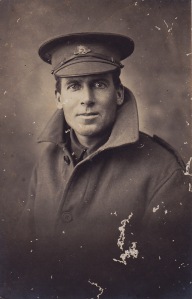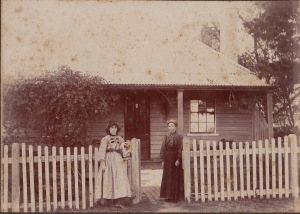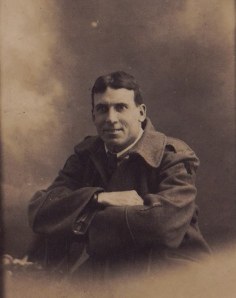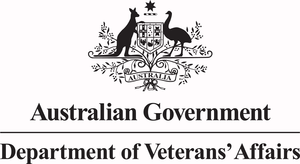Private Walter Henry Brewster – Annette Lemercier (soprano)
53rd Battalion. 6th Reinforcement AIF 1916-18
Walter was my great-uncle, my grandmother’s brother. The core of the story arises from family photographs and reminiscences of my aunt, his niece Dulcie Elsie Coogan (b 1918). Most of this is confirmed by army and historical records.
Early Life in Liverpool
When Walter was born in 1884, his father Richard was overseer of a farm which was part of the Edensor Park Estate then belonging to William Henry Harris, a relative of John Harris, Mayor of Sydney. Edensor House was built by early land owner John Bossley in the 1840s and at the time of Walter’s birth the property focussed on timber-getting, cattle-raising and agistment, crop cultivation and citrus orchards. His grandfather Charles Brewster had emigrated from Scotland in the 1840s and married an Australian Elizabeth Hunt. His mother Harriet was the daughter of immigrants from Kensington, Surrey, Walter and Ann Smith who arrived in 1852.
Walter was about 2 years old when his parents moved to a cottage in Goulburn St, Liverpool, and his father gained employment in the Collingwood Woolscouring Works near the Georges River. Woolscouring was the cleaning of wool prior to export and at Liverpool the industry began in 1856.
Walter, his four sisters and brother Charlie all attended Liverpool Public School. His older sister Elsie, my grandmother, was Dux of the Superior School (ie a school that offered study beyond primary level). in 1902. For this she won a gold medal. Lennis a younger sister, an accomplished tailoress,operated a successful business from a front room of the family home. Walter and his older brother Charlie were keen sportsmen and in their late teens often received favourable mentions, playing for the Liverpool Admirals and the St Luke’s Football Teams and The Liverpool Independent B Cricket Team. Charlie learnt the trade of Baker and Pastrycook and Walter was a Furnaceman at Clyde Engineering Works and worked here until he joined the army. This enterprise was a major employer in the area and gained contracts for railway locomotives and carriages and agricultural equipment such as windmills and ploughs. By 1950 it was the largest engineering works in the state.
In July 1913 tragedy struck the family. Their father Richard suffered a terrible accident which resulted in his death. An engine driver and fireman for 27 years at the Woolscouring Works, he was in charge of Machine No 2 at the time. While oiling a shaft his sleeve became entangled in a belt causing grievous injuries which lead to his death. Naturally this was devastating for the Brewster family and the moral and financial support of Walter and Lennis, still living at home, was no doubt important to their mother.
Private Walter Brewster
Before joining up Walter and other members of the Liverpool Single Men’s Association had raised considerable funds for the war effort, as reported in The Cumberland Argus and Fruitgrowers Advocate 26th June 1915 p 4. Less than a year later on 30th March 1916 aged 30 Walter enlisted and was sent to Dubbo Depot for training, assigned to A Company 53rd Battalion. The Evening News reported on 28th August 1916 p 6:
Privates W.H. Brewster and T Bradbury were farewelled at the Liverpool Town Hall and presented with a purse of sovereigns, Balaclava caps and pipes and pouches.
After overstaying his final leave by 2 days and losing pay accordingly, he embarked on 7th October in His Majesty’s Australian Transport Ceramic for Plymouth. John Baxter in Chapter 19 of Paris at the End of the World (2014, Harper Perennial) tells of his grandfather Archie’s experience on the same voyage where frequent boxing matches kept the troops occupied. After a month in England the men left Folkstone on the Princess Clementine for Étaples at the mouth of the River Canche. On 10th February, 1917 Walter joined the 53rd Battalion on the battlefields of the Somme. According to the Australian War Memorial’s account of the battalion’s action before this time:
The battalion arrived in France on 27 June 1916, entered the front line for the first time on 10 July, and became embroiled in its first major battle on the Western Front, at Fromelles on 19 July. The battle of Fromelles was a disaster. The 53rd was part of the initial assault and suffered grievously,incurring 625 casualties……..but despite these losses it continued to man the front in the Fromelles sector for further two months. (Australian War Memorial ’53rd Battalion’)
When Walter arrived in December 1916 as part of the 6th reinforcement the battalion had moved to the region NE of Albert. Their War Diary shows that they were,with the 56th Battalion , engaged in pushing the Front Line further east as the Germans retreated to the Hindenberg Line. Leaving camp at Trones Wood on 1st March they moved to the Intermediate and then the Front Line, moving back to pause on 9th March and forward again to the Front on 13th March. On 17th March they
…moved forward, entering Heaven Trench at 4.17am just as the enemy was leaving same and established the Battalion Front Line on the old enemy Beaulencourt-Transloy Front Line. (53rd Bn War Diary, March 1917, National Archives of Australia)
After a pause they moved forward on 28th March to the line between the villages of Beaulencourt and Transloy , east of Bapaume and Péronne. The following day proved to be the worst in March: five men and an officer were killed and 15 wounded. One of the wounded was Walter, who sustained a gun shot wound to his left forearm – just one year after he had enlisted. Medical assistance was well-organised and prompt.
The 15th Aust Field Ambulance conveyed him to a Casualty Clearing Station and by 2nd April he was at the 1st Australian General Hospital in Rouen. Sent to England on the hospital ship West Australia he spent nearly 2 months in the 1st London General Hospital, Camberwell and then given a fortnight’s furlough in July 1917. Apparently overcome by the heady taste of freedom – or simply reacting to the stress of the whole experience – he was found on the 27th July to have committed an offence, being:
1 Drunk and disorderly on Trowbridge Railway Station about 9.20pm
2.Using obscene language
3.Violently resisting the Military Police.
For this the penalty was a deduction of 7 days’ pay. At the end of August he was sent home on the NZ Transport Pakeha, arriving on 10th October. He continued to receive treatment for his arm until January 1918 and was discharged medically unfit for AIF service on 16th March, 1918.
For his war service he received three medals- the 1914-15 Star, the British War Medal and the Victory Medal.
Home to Liverpool
Although Walter’s injury did not cause him a disability as serious as that of others, it is probable that he was unable to fulfil the heavy physical demands of his former job of Furnaceman. He was subsequently employed as a Storeman ‘at the Army Depot at Liverpool’, according to family anecdote. This was probably the Ordnance and Ammunition Stores at Holsworthy, one of the several army facilities in the area set up during WW1.

Harriet Brewster, son Walter Brewster with great-granddaughter Annette. Bigge St, Liverpool 19.6.1948
He remained single and lived with his mother at 60 Bigge St for the rest of his life. His brother Charlie and wife Charlotte were raising seven daughters nearby so there was presumably much to occupy him. As a mark of respect for the war service of Walter and others like him, his sister my grandmother Elsie Coogan attended each year the Anzac Day Dawn Service in Martin Place. It is said that she was also more tolerant of beer-drinking at Christmas Day celebrations because of Walter’s fondness for a few beers.
His mother died at the age of 96 on 28th October 1953 and her obituary states:
Mrs Brewster enjoyed the distinction of being the oldest resident of the town. The youngest son Walter lived with his mother at their home in Bigge Street and was a tower of strength to her during her lifetime.
Battles of the Somme are commemorated locally at Moorebank in streets named Bapaume, Ypres, and Amiens.
Sources
Australian Heritage Database http://www.environment.gov.au
Australian War Memorial http://awm.gov.au/research/infosheets/served_ww1/
Clyde Engineering Works http://www.powerhousemuseum.com
Fairfield, A History of the District, Vance George 2nd Ed 1991 Fairfield Council
National Archives of Australia http://www.naa.gov.au/collection/explore
War Diary, 53rd Battalion March 1917, National Archives of Australia
Western Sydney Thematic History, Terry Kass 2005 NSW Heritage Office









